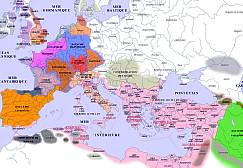Gregory

An Online Encyclopedia of Roman Emperors
Gregory (646-47 A.D.)
R. Scott Moore
Revolt and Brief Reign
Gregory, a distant relative of Heraclius (son of Heraclius' cousin Nicetas) became exarch of Carthage during Heraclius' reign. The exarchate of Carthage was very unsettled at this time due to religious conflict caused by friction between the mainly orthodox provincial population and an influx of Monothelite refugees from Egypt, including a group of zealous Monothelite nuns. Heraclius, looking for a solution to the debate over the nature of Christ, had seen monotheletism (one will) as a compromise between Chalcedonian or Orthodox supporters (two natures united without confusion) and Monophysites (one nature) and proclaimed it in his Ekthesis in 638. In an effort to alleviate the religious conflict in the exarchate, Gregory arranged a public debate (disputation) between the most prominent Orthodox supporter, Maximus the Confessor, and the monothelite Pyrrhus, patriarch of Constantinople, in July of 645. Pyrrhus had supported Martina following Heraclius' death and, with her exile after the ascension of Constantine III, he left Constantinople for Carthage, but was never canonically deposed. Following the public debate, Pyrrhus converted to Orthodoxy and accompanied Maximus to Rome to support Pope Martin I.
In late 646, Gregory, with the support of the Orthodox population in the exarchate and the aid of nearby Moorish tribes, rebelled against Constans II citing religious reasons. Fortunately for the emperor, who was unprepared for this sudden challenge to his imperial authority, Gregory was soon distracted by an invading Arab army. In early 647, an Arab army under the command of Abdallah invaded western Tripolitania after successfully consolidating earlier Arab conquests in Egypt. Gregory gathered an army and forced a battle on the plains near Sufetula were he was defeated and killed.
Primary Source Bibliography
Liber pontificalis.
Theophanes. Chronographia.
Bibliography
Diehl, C. L'Afrique byzantine. Paris,1896.
Guery, R. "Le pseudo-monnayage de l'usurpateur Gr goire, patrice d'Afrique." Bulletin de la societ francaise de numismatique (1981), 66-68.
Haldon, J.F. Byzantium in the Seventh Century: the transformation of a culture. Cambridge, 1990.
Herrin, Judith. The Formation of Christendom. Princeton, 1987.
Kaegi, Jr. Walter Emil. Byzantine Military Unrest, 471-843: an interpretation. Amsterdam, 1981.
Kazhdan, Alexander P. Oxford Dictionary of Byzantium. New York, 1991. S.v. "Gregory" by Paul A. Hollingsworth.
Ostrogorsky, George. Geschichte des byzantischen Staates. Munich, 1963.
Pringle, D. The Defence of Byzantine Africa from Justinian to the Arab Conquest. Oxford, 1981.
Stratos, A.N. Byzantium in the Seventh Century. Amsterdam, 1968.
Treadgold, Warren. A History of Byzantine State and Society. Stanford, 1997.
Vasiliev, A.A. History of the Byzantine Empire. Madison, Wisconsin, 1952.
Copyright (C), R. Scott Moore. This file may be copied on the condition that the entire contents, including the header and this copyright notice, remain intact.
For more detailed geographical information, please use the DIR/ORBAntique and Medieval Atlas below. Click on the appropriate part of the map below to access large area maps.

 DIR Atlas
DIR Atlas